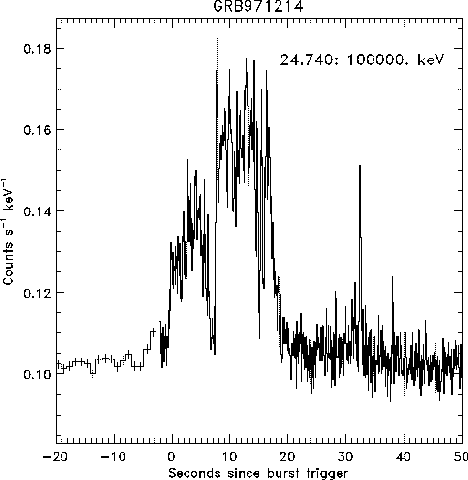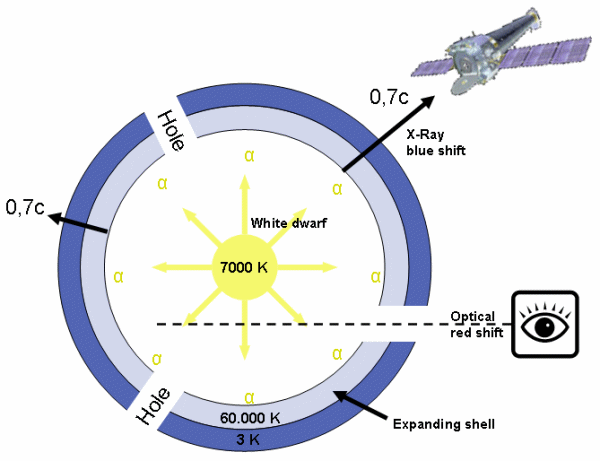ELECTRIC GRBs
published: 5th Huntsville Gamma-Ray Burst Symposium 1999 Oct. 19-23, USA, Alabama TP1 Thesis
The GRB clearly is the electric explosion of a white dwarf in our galactic arm. The missing gravity-lens-effect and the incredible big energy of a cosmological explosion - which is impossible with known physics - suggest rather a source in our proximity which is at least energetically clearly possible.

Picture courtesy of NASA
Sharp and short pulses show a near and small source. The start with gamma rays and the later appearing visible photons and other weaker photons suggest a cold explosion, therefore:
- NO ACCRETION DISC,
- NO MERGER OF NEUTRON STARS,
- NO HYPERNOVA,
- NO FIREBALL AT ALL,
All these processes would be not only hot but also too big to send pulses of a length of one second. The source of a GRB must be smaller than 1 lightsecond. The white dwarf is at least 20 times smaller, it can send photons in rhythm of 0.1 - 0.05 s. The GRB explosion is similar to the cold explosions of solar flares and of a fissure of an U-atom. In these processes, protons accelerate protons and gamma rays are emitted. In a lightning, electrons accelerate electrons and this process produces
gamma rays in a cold way.
The last phase of a white dwarf (Abell 30) before its electric total-explosion: it pushes off its colder parts as positive helium-fingers (left: HST). X ray activity is shown by ROSAT on the right. Both sizes are
18 x 18 arcsec.
1.1 Electric explanation of a white dwarf
A white dwarf contains positive charge which produces its strong magnetic field in quick rotation, its X ray as an anode, and a cold emission of X ray- active (positive) fingers, see Abell 30. The positive charge of mostly alpha-particles cannot explode as long as the dwarf is hot and, therefore, it is a plasma-sphere. The photons of the electrostatic repulsion run along a zigzag course and are, therefore, ineffective in the plasma. (See the plasma-phase of the Big-Bang.) But during the natural cool-down of a white dwarf, it becomes gas and explodes electrostatically at once due to its relativistic (degenerated) electrons which equalize its temperatures in the depth. These GRBs increase the mass of the X ray active halo of the galaxies which are not 10 MK hot but positively charged. These huge and positive masses - the "cemetery" of the supernovae and white dwarfs - produce the filaments of the superclusters and the accelerated expansion of the Universe.
1.2 Questions
Why do GRBs emit gamma rays ?
- because positive ions accelerate positive ions in it. The GRBs and solar flares pulse similarly ( see the book The Electric Universe p576-626).
Why is no celestial body on the position of a GRB later?
- because the white dwarf totally exploded by its own electric charge.
Will Chandra see something on the position of an older GRB ?
- yes, an expanding X ray cloud with radial filaments, similar to an SNR. The mass is smaller but the expansion is much quicker as those at a SNR - which is no electric but a thermal explosion of charged masses.
Why does a GRB either send no visible photons at all - or those only later ?
- because this explosion is not hot. It produces heat if and when the electrically exploded ions collide into a nebula around the white dwarf. No nebula - no collision, the ions can infinitely diverge.
Why does the visible afterglow show a big redshift ?
- because the whole body of the white dwarf is in collision with the nebula around the white dwarf. The electric force is very strong. Measurements show immediately a velocity of 0.9999c of charged particles and a brake-down to about 0.7c in some days. This is surely due to the swept away masses of the nebula. The inside of the shell glows, but the outside is still cold. We see only the rejected shell from inside with a redshift caused by 0.7c, the approaching shell shows its cold side to us. The receding afterglow can only be seen through holes in the approaching shell. Only Chandra will see that the X ray from the inside of the shell shows a redshift and a blueshift, both caused by 0.7 c.

Why does the X ray of a GRB show that these photons came through a cloud ? -The X ray was released in the inside of the approaching shell.
Why do we find GRBs from all directions ?
-because white dwarfs are everywhere in our proximity and we probably cannot detect them if their distance is longer than 1000 lightyears.
Why is a deficit of weak GRBs ?
-because white dwarfs have a low limit. These weak GRBs will be the electric death of stars of e.g. 0.8 sunmasses which now burn their hydrogen.
* Dr Körtvélyessy, candidate of the Hungarian Academy of Sciences , Obser. Kleve drlaky (at) aol.com
